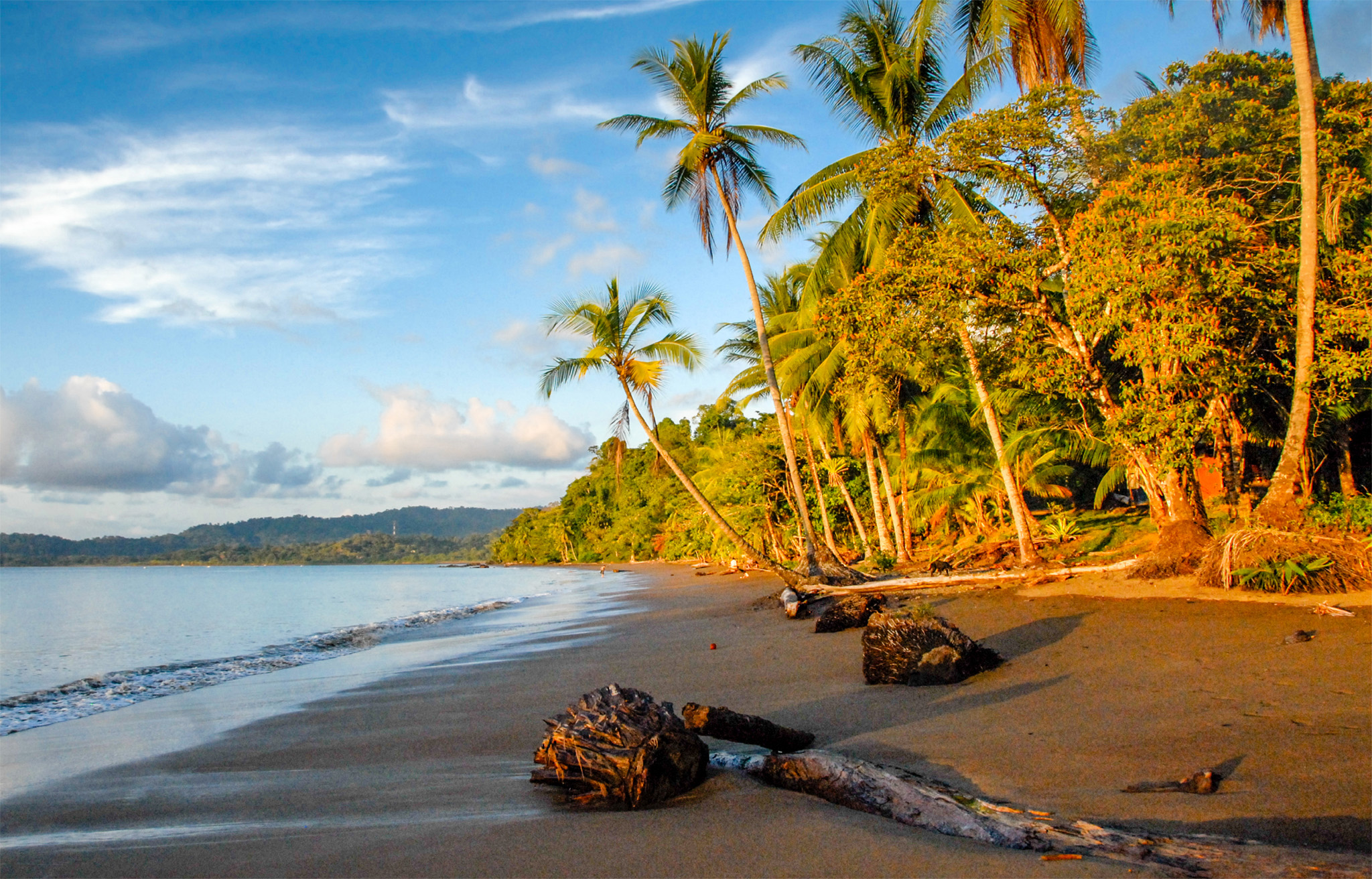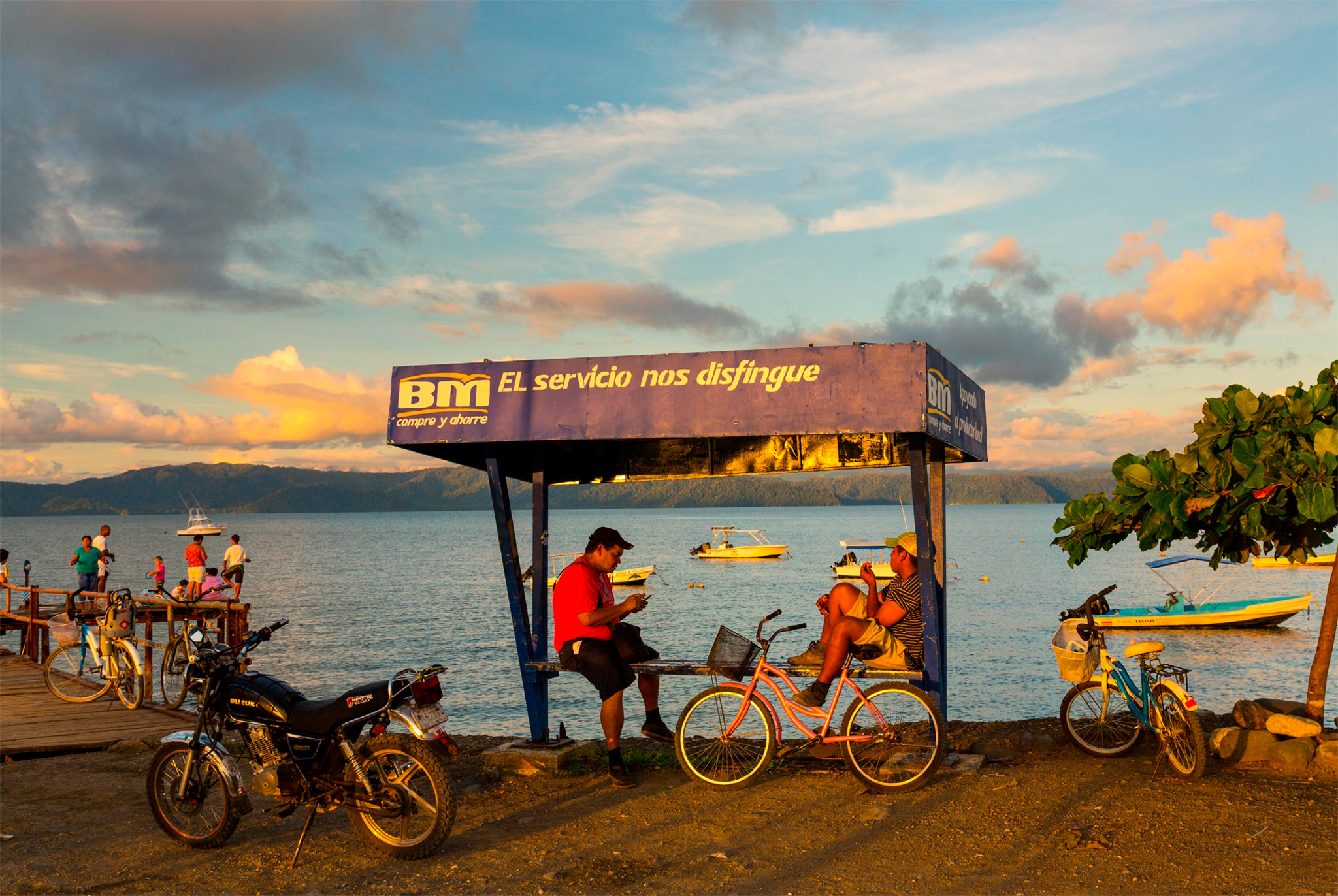Washed on three sides by warm Pacific waters, the isolated, nearly untouched Osa Peninsula curls around the Golfo Dulce, with the lush rainforests of Corcovado lying at its heart. Although tourism to the region is booming, travel into the interior is still a challenge. Highway 245 follows the eastern shore and a rugged dirt road links Rincón to Bahía Drake, but the only guaranteed access to the western shores is by boat or small plane.

t Ideal for scuba diving and sportfishing, the calm seas of beautiful Bahía Drake
EXPERIENCE Southern Zone

n Double-tap image to read the labels
The peninsula was once a center for the pre-Columbian Diquís culture, whose skill as goldsmiths sent Spanish conquistadors on a futile search for fabled gold mines. Deluged by year-round rains, much of this rugged area remains uninhabited and trackless, and is covered with virgin rainforest. About half of Osa is protected within sprawling Parque Nacional Corcovado, the largest of the parks and reserves that make up the Corcovado Conservation Area, set aside to preserve one of the last original tracts of the Pacific coast’s tropical rainforest in Mesoamerica. Those with a taste for adventure are rewarded with wilderness and some of the most spectacular wildlife-viewing in the nation. Wilderness lodges offering a variety of activities line the coast, and tours of the national park with local guides are available from one of the four ranger stations.
Gold Mining
Oreros (gold panners) had sifted for gold in the rivers of the Osa Peninsula since pre-Columbian days. When the United Fruit Company pulled out of the region in 1985, unemployed workers flooded the peninsula, leading to a latter-day gold rush. Though short-lived, it caused major damage: trees were felled, river banks dynamited, and exposed soils sluiced. After violent clashes with the authorities, the oreros were ousted in 1986. Some still work the outer margins of Corcovado, while others make a living leading gold hunts for tourists.

INSIDER TIP
The Bug Lady
A nighttime insect tour of the rainforest with biologist Tracie Stice (the “Bug Lady”) and naturalist Giancomo Gómez reveals a world unseen by day, with fascinating tidbits from the guides (www.thenighttour.com).
Did You Know?
The Osa Peninsula has 2.5% of the planet’s biodiversity, but occupies just 0.001% of its surface area.
Rocky cliffs and forested hills provide a compelling setting for this scalloped bay, one of the most inaccessible areas in Costa Rica. The dirt road from Rincón is often impassable, and most visitors arrive by boat from the village of Sierpe. Among the activities available are whale-watching, snorkeling, and kayaking, as well as zip-line in the verdant rainforest with Corcovado Canopy Tours.
From Agujitas, a coastal trail leads south for 8 miles (13 km) to Parque Nacional Corcovado, passing Refugio Nacional de Vida Silvestre Punta Río Claro, both of which teem with wildlife. When canoeing on Laguna Chocouaco, to the east of Augjitas, tapirs and crocodiles are often sighted.
Corcovado Canopy Tour
⌂ Los Planos, 8 miles (14 km) SE of Agujitas ∑ corcovadocanopytour.com
" '
Refugio Nacional de Vida Silvestre Punta Rio Claro
⌂ Playa Caletas, 4 miles (6 km) S of Agujitas # 8am–6pm daily ∑ puntamarenco.com

t Cyclists taking a well-earned break beside the water in the former gold-rush village of Puerto Jiménez
The main settlement on the peninsula, this dusty village is popular with backpackers. In the 1980s, it briefly blossomed on income from local gold and gained a “Wild West” reputation, where gun carrying was considered a good idea and prostitutes were paid with gold nuggets. Today, the town thrives on tourist trade. Various adventure activities are available. Kayakers flock to the east, where mangroves extend along the shore of the Golfo Dulce to the estuary of the Río Platanares. Home to crocodiles, caimans, freshwater turtles, and river otters, this ecosystem is protected within the 555-acre (225-ha) Refugio Nacional de Vida Silvestre Preciosa Platanares. Along the shores of the lovely Playa Platanares, it has a small coral reef that is good for snorkeling. The beach is a nesting site for five species of marine turtles, and a small vivero (nursery) raises hatchlings for release into the jade-green waters.
The shore south of Puerto Jiménez is lined with beaches. Cabo Matapalo, at the tip of the peninsula, and Playa Sombrero offer great surfing.
" '
Refugio Nacional de Vida Silvestre Preciosa Platanares
⌂ 2 miles (3 km) E of Puerto Jiménez

t A narrow stretch of river breaking across a trail in Corcovado National Park
Considered the crown jewel among the protected regions of the humid tropics, this 165-sq-mile (425-sq-km) park was created in 1975 to preserve the largest Pacific coast rainforest in the Americas, as well as 20 sq miles (52 sq km) of marine habitat. Corcovado (meaning “hunchback”) has eight distinct zones, including herbaceous swamps, flooded swamp forest, and montane forest. The area receives up to 158 inches (400 cm) of rainfall per year, with torrential rains from April to December.
Wildlife viewing is splendid and among the most diverse in Costa Rica. The park has over 400 species of birds, including the endangered harpy eagle, and the largest population of scarlet macaws in Central America; bird-watchers who make the trek into the park are rewarded with guaranteed sightings. Jaguars are spotted more frequently here than at any other park in the nation, as are tapirs. Both species can often be seen on the beaches, especially just before sunset. Corcovado is also known for its large packs of peccaries – wild hogs which look cute but should be avoided. The titi, an endangered squirrel monkey, is also found here. There are in excess of 115 species of amphibians and reptiles. Look out for poison-dart frogs, easily seen in their gaudy livery; the elusive lime-green red-eyed tree frog and tiny Fleischmann’s transparent frog are harder to spot. On the beaches, the fortunate might even witness green, hawksbill, leatherback, or Pacific ridley turtles as they crawl ashore to nest. Unfortunately, the park is understaffed and its wildlife is under threat by poachers.
Although there are hotels and organized tours close by, the park is best suited to self-sufficient hikers who enjoy rugged adventures. There are four official entry points and ranger stations. San Pedrillo, to the west, is linked by a trail from Bahía Drake. In the east, Los Patos can be reached from La Palma, 12 miles (19 km) northwest of Puerto Jiménez. La Leona, to the south, is just 1 mile (1.6 km) west of the airstrip at Carate, a tiny hamlet 25 miles (40 km) west of Puerto Jiménez; visitors must then hike or ride a horse from Carate. Sirena, the main ranger station, is 10 miles (16 km) northwest of La Leona and 16 miles (26 km) southeast of San Pedrillo. Trails connecting the stations are poorly marked, so it is wise to hire a guide.
The two-day coastal San Pedrillo–La Leona trail passes the dramatic 100-ft- (30-m-) high Cascada La Llorona. Be prepared on this hike to ford rivers inhabited by crocodiles. The northern section is open only from December to April. The San Pedrillo–Los Patos trail allows access to Laguna Corcovado, where tapirs and jaguars are often sighted.
There is no scheduled air service to the airstrips near the park, but air-taxis are offered by charter companies. Interesting attractions close to the Parque Nacional Corcovado include Humedal Lacustrino Laguna Pejeperrito wetlands, 2 miles (3 km) east of Carate, and the 2-sq-mile (3-sq-km) Refugio Nacional de Vida Silvestre Pejeperro, 2 miles (4 km) farther east. They are little visited, but offer good opportunities for birdwatching, as well as for spotting crocodiles.
Did You Know?
Corcovado’s rivers are home to caimans, crocodiles, and bull sharks.
EXPERIENCE Southern Zone
|
Stay Luna Lodge Zen and eco-awareness go hand-in-hand at this ocean-facing lodge with jaw-dropping views. ⌂ Carate ∑ lunalodge.com \ Finca Maresia Unpretentious luxe defines this hilltop boutique hotel with ocean views. ⌂ Drake Bay ∑ fincamaresia.com \ Iguana Lodge Delightful hosts, and gourmet organic fare highlight this laid-back beachfront lodge. ⌂ Playa Platanares ∑ iguanalodge.com \ Lapa Rios This deluxe rainforest eco-lodge has romantic ridge-top villas and good food. ⌂ Cabo Matalpo ∑ laparios.com \ |
